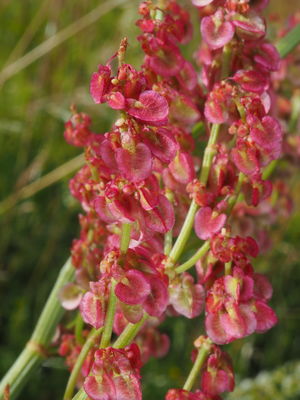-
General Description
-
Common sorrel is today used in sauces and as a spinach or salad leaf; the sap can be used as a laundry stain-remover.
Rumex acetosa, also known as common sorrel, is a herbaceous plant native to the British Isles. It was once cultivated as a vegetable but is now merely a wild food plant; it is also used in herbal medicine for its diuretic properties.
The species belongs to a group of plants commonly known as docks. They can be bisexual or have male or female flowers on separate plants. The leaves of the common sorrel are acidic to taste and contain high levels of oxalic acid. The larvae of several species of butterflies and moths, including the blood-vein moth, feed on the leaves of sorrel.
The leaves are used in herbal medicine for their cooling and diuretic properties. They were once eaten to prevent or treat scurvy. Sorrel is also used to treat sinusitis and cancer.
-
Species Profile
-
Geography and distribution
Common sorrel is native to the British Isles.
Description
Common sorrel is a herbaceous perennial growing to a height of about 1 m, with stems arising from a short underground one. The leaves are large, ovate in outline and have characteristic, pointed basal leaf lobes that direct backwards; the leaves are sour to taste. The small pinkish flowers are unisexual (either male of female) and are sometimes only present on separate plants. They are in whorls on the flowering stems and have six rounded tepals with a small tubercle near the base; the inner three enlarge when the fruit matures and envelope it. The fruit is a triangular achene.
Variations in certain characteristics related to particular habitats reveal three subspecies. One of these is found on coastal dunes of north-west, west and south Ireland, north Scotland, south-west England and south-west Wales and is restricted to these regions; the second is found on sea cliffs in west Cornwall; the third is of unknown origin and is introduced. This subspecies is grown as a vegetable but can be found naturalised in Hertfordshire and East Suffolk.
Uses
Common sorrel was a popular cultivated vegetable in Europe until the Middle Ages, when improved varieties of related species replaced it. Today, it is gathered from the wild for use in sauces, and as a spinach or salad leaf. The sap can be used as a laundry stain-remover.
Millennium Seed Bank: Seed storage
Kew's Millennium Seed Bank Partnership aims to save plant life world wide, focusing on plants under threat and those of most use in the future. Seeds are dried, packaged and stored at a sub-zero temperature in our seed bank vault.
Number of seed collections stored in the Millennium Seed Bank: Three
Seed storage behaviour: Orthodox (the seeds of this plant survive being dried without significantly reducing their viability, and are therefore amenable to long-term frozen storage such as at the MSB)
Germination testing: Successful
-
Distribution
-
United Kingdom
-
Ecology
-
Grassland, coastal dunes and cliffs.
-
Conservation
-
Least concern; common and widespread.
-
Hazards
-
The presence of oxalic acid in the plant may pose risks for people with rheumatic-type complaints, kidney or bladder stones.
























